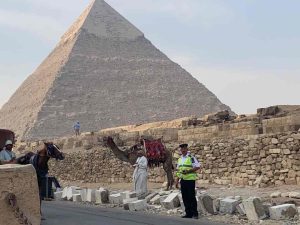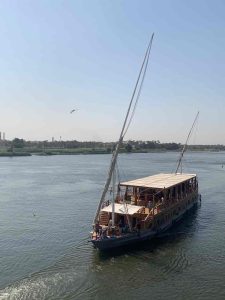By Dr Jo Grey, Launceston Medical Centre
Egypt, with its long history of successive waves of invasion, occupation and religious upheaval has held a lifelong fascination for me. So when offered the opportunity to spend three weeks exploring the Nile Valley with its myriad tombs and temples, I jumped at the chance. Travelling as accompanying doctor on a custom designed exploration of the Nile Valley, I visited all the sites I had read about since childhood (and many I hadn’t heard about).
Advice to prospective passengers for travel preparation involved the usual checklist for developing countries (Hepatitis A, typhoid) plus ensuring routine immunisation such as influenza, COVID-19, measles/mumps/rubella and diphtheria/tetanus/pertussis were up to date. There was an alert regarding a dengue outbreak around Luxor the month before we departed, so insect avoidance/use of repellent was also emphasised, as was the need to be prepared for hot conditions and lots of walking plus climbing stairs.
Our journey started with a flight from Cairo to Abu Simbel. The tombs of Ramses II and his queen were moved to this site in the late 1960’s to avoid these ancient monuments being lost forever under the waters of the Aswan Dam. The temperatures in Upper Egypt (the most southern part, near the Sudanese border) hovered in the low 40s Celsius in the shade. Walking around the temple sites without any shade was particularly difficult for those in the group unaccustomed to the combination of heat, exercise and uneven surfaces. Portable shade, in the form of an umbrella, is a highly recommended travel accessory, as is an insulated refillable water bottle (ideally containing electrolyte solution to sip during outings).

After another short 45 minute flight from Abu Simbel, we joined our home for two weeks, a beautifully appointed small ship in Aswan, From Aswan, the ship took us at a leisurely pace down the length of the Nile until we reached Cairo. Each day, we visited one or two tomb or temple sites, touring in the morning to avoid the worst of the heat and spending the afternoons relaxing or board or attending lectures even by our accompanying Egyptologists.

For me, the highlights of the tour were being given access to the feet of the Great Sphinx at Giza and private access to the National Museum in Cairo, prior to the museum opening to the general public. I was thrilled to be able to enter the Tutankhamen Room absolutely alone and stand in awe before the gold headpiece which I have admired in photographs all my life.
One unexpected aspect of our trip was the police presence and security measures that were in place throughout the tour and some passengers initially found alarming. There was a group of uniformed police and plain clothes security officers who travelled on the ship at all times.
Additionally, at each site we docked and went touring, our group was accompanied by police vehicles in convoy with our bus, often with lights and sirens. On evenings when we left the ship to enjoy a walk along the corniche in the various cities, we were accompanied by squads of armed police toting machine guns and sometimes a convoy of police vehicles driving beside us, preventing other vehicles from coming past us.
This was simultaneously reassuring and disconcerting but we soon learnt to focus on the street life rather than the police presence. Given the current situation in the Middle East now, it’s likely that these security measures for tourists have been further strengthened.
If you’re planning to travel, whether domestically or abroad, I can assist with your preparation at Launceston Medical Centre. I provide personalised advice surrounding everything from vaccinations, to precautions and medication to take with you. Book your appointment here.

